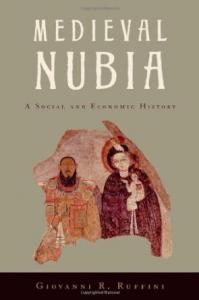Medieval Nubia. A Social and Economic History
CODICE: ISBN 019989163X EAN 9780199891634
AUTORE/CURATORE/ARTISTA :
Autore: Giovanni R. Ruffini
EDITORE/PRODUTTORE : Oxford University Press
COLLANA/SERIE :
DISPONIBILITA': In esaurimento
TITOLO/DENOMINAZIONE:
Medieval Nubia. A Social and Economic History
PREZZO : EUR 60,00€
CODICE :
ISBN 019989163X
EAN 9780199891634
AUTORE/CURATORE/ARTISTA :
Autore: Giovanni R. Ruffini
EDITORE/PRODUTTORE:
Oxford University Press
ANNO:
2012
DISPONIBILITA':
In esaurimento
CARATTERISTICHE TECNICHE:
320 pages
8 b&w illustrations, 1 map
Hardback
cm 15,6 x 23,5
gr 540
DESCRIZIONE:
Publisher's description:
- Uses native (Old Nubian) language evidence never before published
- Challenges previous interpretations claiming that Nubia had no private property and no monetized economy
Among the few surviving archaeological sites from the medieval Christian kingdom of Nubia—located in present day Sudan—Qasr Ibrim is unique in a number of ways. It is the only site in Lower Nubia that remained above water after the completion of the Aswan high dam. In addition, thanks to the aridity of the climate in the area the site is marked by extraordinary preservation of organic material, especially textual material written on papyrus, leather, and paper. Particularly rich is the textual material from the twelfth and thirteenth centuries CE, written in Old Nubian, the region's indigenous language. As a result, Qasr Ibrim is probably the best documented ancient and medieval site in Africa outside of Egypt and North Africa.
Medieval Nubia will be the first book to make available this remarkable material, much of which is still unpublished. The evidence discovered reveals a more complicated picture of this community than originally thought. Previously, scholars had thought medieval Nubia had existed in relative isolation from the rest of the world and had a primitive economy. Legal documents, accounts, and letters, however, reveal a complex, monetized economy with exchange rates connected to those of the wider world. Furthermore, they reveal public festive practices, in which lavish feasting and food gifts reinforced the social prestige of the participants. These documents show medieval Nubia to have been a society combining legal elements inherited from the Greco-Roman world with indigenous African social practices. In reconstructing the social and economic life of medieval Nubia based on the Old Nubian sources from the site, as well as other previously examined materials, Giovanni R. Ruffini will correct previous assumptions and produce a new picture of Nubia, one that connects it to the wider Mediterranean economy and society of its time.
Table of contents:
Acknowledgments
Introduction: Qasr Ibrim and Christian Nubia
Chapter One: Qasr Ibrim's Land Sales
Chapter Two: Mashshouda and Archive 3
Chapter Three: The Historiography of Nubian Land Tenure
Chapter Four: Nubian Land Sales as a Legal Genre
Chapter Five: Nubian Land Sales as Ceremony
Chapter Six: Nubia's Legal Tradition
Chapter Seven: Money, Rent, Taxes and Investment
Chapter Eight: Qasr Ibrim's Other Archives
Conclusion
Appendix 1: The Chronology of Archive 3
Bibliography
Index
GENERE: Libri ,Saggi ,



